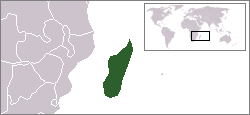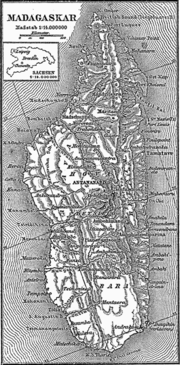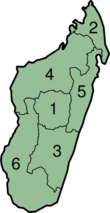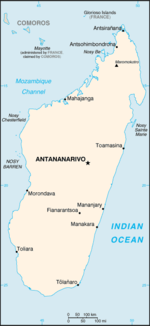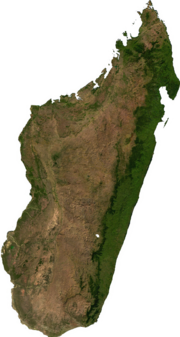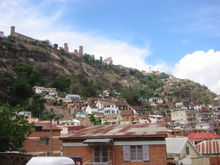Madagascar
2007 Schools Wikipedia Selection. Related subjects: African Countries; Countries
| Repoblikan'i Madagasikara République de Madagascar Republic of Madagascar |
|||||
|
|||||
| Motto: "Tanindrazana, Fahafahana, Fandrosoana" ( Malagasy) "Ancestral-land, Liberty, Progress" |
|||||
| Anthem: Ry Tanindraza nay malala ô Oh, Our Beloved Ancestral-land |
|||||
| Capital (and largest city) |
Antananarivo |
||||
| Official languages | Malagasy, French | ||||
|---|---|---|---|---|---|
| Government | Republic | ||||
| - President | Marc Ravalomanana | ||||
| - Prime Minister | Jacques Sylla | ||||
| Independence | from France | ||||
| - Date | 26 June 1960 | ||||
| Area | |||||
| - Total | 587,041 km² ( 45th) 226,597 sq mi |
||||
| - Water (%) | 013% | ||||
| Population | |||||
| - July 2005 estimate | 18,606,000 ( 56th) | ||||
| - 1993 census | 12,238,914 | ||||
| - Density | 32/km² ( 171st) 83/sq mi |
||||
| GDP ( PPP) | 2005 estimate | ||||
| - Total | $16.228 billion ( 118th) | ||||
| - Per capita | $905 ( 169th) | ||||
| HDI (2004) | 0.509 (medium) ( 143th) | ||||
| Currency | Malagasy ariary ( MGA) |
||||
| Time zone | EAT ( UTC+3) | ||||
| - Summer ( DST) | not observed ( UTC+3) | ||||
| Internet TLD | .mg | ||||
| Calling code | +261 | ||||
| 1 Malagasy is the national language according to the Constitution. French is considered a de facto official language. | |||||
Madagascar (officially the Republic of Madagascar) or Malagasy Republic, is an island nation in the Indian Ocean, off the southeastern coast of Africa. The main island, also called Madagascar, is the fourth largest island in the world, and is home to five percent of the world's plant and animal species, (more than 80 percent of which are indigenous to Madagascar.) Most notable are the lemur infraorder of primates, the carnivorous fossa, three endemic bird families and six endemic baobab species. The adjective for Madagascar is Malagasy (pronounced "mal-la-gas-ee" or "mal-a-gash"), and the official national language is the Malagasy language.
History
The first settlers came from Asia, rather than Africa, circa 700 AD. The culture shows the influence of both Africa and Asia. The settlement represented the western-most branch of the great Austronesian expansion. Some of the strongest evidence indicating that the settlers of Madagascar came from this region is the linguistic similarity between the Malayo-Polynesian and Malagasy languages.
The written history of Madagascar began in the 7th century, when Arabs established trading posts along the northwest coast. European contact began in the 1500s, when Portuguese sea captain Diego Dias sighted the island after his ship separated from a fleet going to India. In the late 17th century, the French established trading posts along the east coast. From about 1774 to 1824, it was a favourite haunt for pirates, including Americans, one of whom brought Malagasy rice to South Carolina.
During the Middle Ages, the chiefs of the different settlements began to extend their power through trade with Indian Ocean neighbors, notably North Africa, the Middle-east and India. Large chiefdoms began to dominate considerable areas of the island. Among these were the Sakalava chiefdoms of the Menabe, centered in what is now the town of Morondava, and of Boina, centered in what is now the provincial capital of Mahajanga ( Majunga). The influence of the Sakalava extended across what is now the provinces of Antsiranana, Mahajanga and Toliara. But with the domination of the Indian Ocean by the British fleet and the end of the Arab slave trade, the Sakalava would lose their power to the emerging Merina threat. For a short time the Betsimisaraka of the east coast also unified, but this unification was short-lived.
Beginning in the 1790s, Merina rulers succeeded in establishing hegemony over the major part of the island, including the coast. In 1817, the Merina ruler and the British governor of Mauritius concluded a treaty abolishing the slave trade, which had been important in Madagascar's economy. In return, the island received British military and financial assistance. British influence remained strong for several decades, during which the Merina court was converted to Presbyterianism, Congregationalism, and Anglicanism.
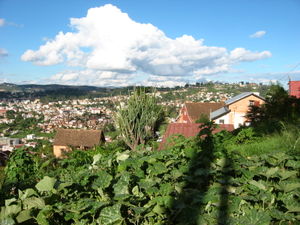
France invaded Madagascar in 1883 in what became known as the first Franco-Hova War (Hova being the name of the Merina aristocrats), seeking to restore property that had been confiscated from French citizens. At the war’s end, Madagascar ceded Antsiranana (Diego Suarez) on the northern coast to France and paid 560,000 gold francs to the heirs of Joseph-François Lambert. The British accepted the imposition of a French protectorate over Madagascar in 1885 in return for eventual control over Zanzibar (now part of Tanzania) and as part of an overall definition of spheres of influence in the area.
In Europe, meanwhile, diplomats partitioning the African continent worked out an agreement whereby Britain, to obtain the Sultanate of Zanzibar, ceded its share of Heligoland to Germany and renounced all claims to Madagascar in favour of France. In 1895, a French flying column landed in Mahajanga (Majunga) and marched to the capital, Antananarivo, where the city’s defenders were taken by surprise, as they were expecting an attack from the much closer east coast. Twenty French soldiers died fighting and 6,000 died of malaria and other diseases before the second Franco-Hova War ended.
Absolute French control over Madagascar was established by military force in 1895-1896, and in 1896 the French Parliament voted to annex Madagascar. The 103-year-old Merina monarchy ended with the royal family being sent into exile in Algeria. In December 1904, the Russian Baltic Fleet stopped at Diego Suarez for coal and provisions before sailing on to its doomed encounter with the Japanese Fleet in the Battle of Tsushima. Before leaving port the Russian sailors were required to put ashore the animals they had acquired, including monkeys, boa constrictors and one crocodile.
.
During World War II, Malagasy troops fought in France, Morocco, and Syria. Immediately preceding the fall of France, Germany initiated planning to forcibly deport all of Europe's Jews to Madagascar in what was known as the Madagascar Plan. Action on the plan was never begun. After France fell to Germany, the Vichy government administered Madagascar. British troops occupied the strategic island in 1942 to preclude its seizure by the Japanese. The Free French received the island from the United Kingdom in 1943.
In 1947, with French prestige at low ebb, a nationalist uprising was suppressed after several months of bitter fighting with 100,000 persons killed. The French subsequently established reformed institutions in 1956 under the Loi Cadre ( Overseas Reform Act), and Madagascar moved peacefully toward independence. The Malagasy Republic was proclaimed on October 14, 1958, as an autonomous state within the French Community. A period of provisional government ended with the adoption of a constitution in 1959 and full independence on June 26, 1960.
Politics
Madagascar's first President, Philibert Tsiranana, was elected when his Social Democratic Party gained power at independence in 1960 and was reelected without opposition in March 1972. However, he resigned only 2 months later in response to massive antigovernment demonstrations. The unrest continued, and Tsiranana's successor, Gen. Gabriel Ramanantsoa, resigned on February 5, 1975, handing over executive power to Lt. Col. Richard Ratsimandrava, who was assassinated 6 days later. A provisional military directorate then ruled until a new government was formed in June 1975, under dictator Didier Ratsiraka.
During the 16 subsequent years of President Ratsiraka's rule, Madagascar continued under a government committed to revolutionary socialism based on the 1975 Constitution establishing a highly centralized state. During this period a strategy of nationalization of private enterprises, centralization of the economy and "Malgasization" of the education system crippled the economy, leaving traces even today of a highly centralized economic system and a high level of illiteracy. National elections in 1982 and 1989 returned Ratsiraka for a second and third 7-year presidential term. For much of this period, only limited and restrained political opposition was tolerated, with no direct criticism of the president permitted in the press.
With an easing of restrictions on political expression, beginning in the late 1980s, the Ratsiraka regime came under increasing pressure to make fundamental changes. In response to a deteriorating economy, Ratsiraka relaxed socialist economic policies and instituted some liberal, private-sector reforms. These, along with political reforms like the elimination of press censorship in 1989 and the formation of more political parties in 1990, were insufficient to placate a growing opposition movement known as Hery Velona ("Active Forces"). A number of already existing political parties and their leaders, among them Albert Zafy and Rakotoniaina Manandafy, anchored this movement which was especially strong in Antananarivo and the surrounding high plateau.
In response to largely peaceful mass demonstrations and crippling general strikes, Ratsiraka replaced his prime minister in August 1991 but suffered an irreparable setback soon thereafter when his troops fired on peaceful demonstrators marching on Iavoloha, the suburban presidential palace, killing more than 30.
In an increasingly weakened position, Ratsiraka acceded to negotiations on the formation of a transitional government. The resulting " Panorama Convention" of October 31, 1991, stripped Ratsiraka of nearly all of his powers, created interim institutions, and set an 18-month timetable for completing a transition to a new form of constitutional government. The High Constitutional Court was retained as the ultimate judicial arbiter of the process.
In March 1992, a widely representative National Forum organized by the FFKM (Malagasy Christian Council of Churches) drafted a new Constitution. Troops guarding the proceedings clashed with pro-Ratsiraka " federalists" who tried to disrupt the forum in protest of draft constitutional provisions preventing the incumbent president from running again. The text of the new Constitution was put to a nationwide referendum in August 1992 and approved by a wide margin, despite efforts by federalists to disrupt balloting in several coastal areas.
Presidential elections were held on November 25, 1992, after the High Constitutional Court had ruled, over Hery Velona objections, that Ratsiraka could become a candidate. Runoff elections were held in February 1993, and the leader of the Hery Velona movement, Albert Zafy, defeated Ratsiraka. Zafy was sworn in as President on March 27, 1993. After President Zafy's impeachment by the National Assembly in 1996 and the short quasi-presidency of Norbert Ratsirahonana, the 1997 elections once again pitted Zafy and Ratsiraka, with Ratsiraka this time emerging victorious. A National Assembly dominated by members of President Ratsiraka'a political party AREMA subsequently passed the 1998 Constitution, which considerably strengthened the presidency.
In December 2001, a presidential election was held in which both major candidates claimed victory. The Ministry of the Interior declared incumbent Ratsiraka of the AREMA party victorious. Marc Ravalomanana contested the results and claimed victory. A political crisis followed in which Ratsiraka supporters destroyed bridges and cut major transport routes from the primary port city to the capital to isolate the capital city, a stronghold of Ravalomanana support. Sporadic violence and considerable economic disruption continued until July 2002 when Ratsiraka and several of his prominent supporters fled to exile in France. In addition to political differences, ethnic differences played a role in the crisis and continue to play a role in politics. Ratsiraka is from the coastal Betsimisaraka tribe and Ravalomanana comes from the highland Merina tribe.
After the end of the 2002 political crisis, President Ravalomanana began many reform projects, forcefully advocating "rapid and durable development" and the launching of a battle against corruption. December 2002 legislative elections gave his newly formed TIM (Tiako-I-Madagasikara) (I Love Madagascar) Party a commanding majority in the National Assembly. November 2003 municipal elections were conducted freely, returning a majority of supporters of the president, but also significant numbers of independent and regional opposition figures.
Following the crisis of 2002, the President replaced provincial governors with appointed PDSs ( Presidents des Delegations Speciales). Subsequent legislation established a structure of 22 regions to decentralize administration. In September 2004, the Government named 22 Regional Chiefs, reporting directly to the President, to implement its decentralization plans. Financing and specific powers for the regional administrations remain to be clarified.
On November 18, 2006 General Fidy declared a military coup of President Marc Ravalomanana's government. Presidential elections are next due to be held on December 3, 2006. Until the coup, Marc Ravalomanana was expected to gain more support than any of the 14 candidates standing against him.
On November 18 Ravalomanana's plane was forced to divert from Madagascar's capital during a return trip from Europe following reports of a coup underway in Antananarivo.
Government
In March 1998, Malagasy voters approved a revised constitution. The principal institutions of the Republic of Madagascar are a presidency, a parliament ( National Assembly and Senate), a prime ministry and cabinet, and an independent judiciary. The president is elected by direct universal suffrage for a 5-year term, renewable twice.
The National Assembly consists of 160 representatives elected by direct vote every 5 years. The last election was held in December 2002. The Senate consists of 90 senators, two-thirds elected by local legislators and other Grand Electors and one-third appointed by the president, all for 6-year terms. A prime minister and council of ministers carries out day-to-day management of government. The president appoints the prime minister.
The prime minister and members of Parliament initiate legislation, and the government executes it. The president can dissolve the National Assembly. For its part, the National Assembly can pass a motion of censure and require the prime minister and council of ministers to step down. The Constitutional Court approves the constitutionality of new laws. Madagascar is also part of the Indian Ocean Commission.
Administrative Divisions
|
During the second republic (1975-1991), Madagascar was divided into five levels of government:
|
Today, there are four levels of division:
|
The constitution of 1992 ruled that the country should be decentralized into territorial entities. The name, number, and limits of territorial entities should be determined by law. The law passed by the national assembly in 1994 defined three such entity levels: region ( faritra), department ( departemanta) and commune ( kaominina). The communes were created in 1996.
With Didier Ratsiraka back in power, the constitution was changed in 1998, to include and specifically mention six autonomous provinces, divided into undefined regions and communes. The autonomous provinces, having the same names and territories as the already existing provinces, were created in 2000.
During the power struggle after the presidential elections in 2001, five of those provinces, whose governors supported Ratsiraka, declared themselves independent from the republic. The new president, Ravalomanana, replaced the provincial governments by special delegations, appointed by the president. This effectively means that the autonomous provinces have ceased to exist as such, although it remains unclear whether they will remain in place.
In 2004, the regions were finally created by the national assembly in law no. 2004-001. Meanwhile the 28 regions originally proposed had become 22. Although they are subdivisions of the provinces, they are representatives (and representing the people) of the republic, not the province. The regions will also take over the assets of the "ex-Fivondronampokontany". It is also mentioned that the communes are the only entities that are operational, and there will be an unspecified period of transition to the new system. The departments are not mentioned in the law, instead the designation "components" of the regions is used. It appears that the departments will be based on the Fivondronampokontany, although it is unclear whether they are already in place and what it means that the assets will be taken over by the regions.
Provinces and regions
Madagascar is divided into six autonomous provinces (faritany mizakatena), which in turn are divided into 22 regions:
|
|
|
Geography
At 226,642 mi² (587,040 km²), Madagascar is the world's 46th-largest country (after Botswana) and its fourth largest island. It is comparable in size to Kenya.
The east coast of Madagascar has lowlands leading to steep bluffs and central highlands. The Tsaratanana Massif in the north has volcanic mountains. The west coast has many protected harbors and broad plains, while the southwest is a plateau and desert region.
There are two seasons: it is hot and rainy from November to April, and cooler and dry from May to October. Southeastern trade winds dominate, and there are occasional cyclones.
Ecology
Madagascar's long isolation from the neighboring continents has resulted in a unique mix of plants and animals, many found nowhere else in the world; some ecologists refer to Madagascar as the "eighth continent".
The eastern, or windward side of the island is home to tropical rainforests, while the western and southern sides of the island, which lie in the rain shadow of the central highlands, are home to tropical dry forests, thorn forests, and deserts and xeric shrublands. Madagascar's dry deciduous forests have been preserved generally better than the eastern rainforests or the high central plateau, presumably due to historically less population density and scarcity of water. There has been some slash-and-burn activity, locally called 'tavy', in the eastern and western dry forests as well as the central high plateau, reducing certain forest habitat and applying pressure to some endangered species. Slash-and-burn is a method sometimes used by shifting cultivators to create short term yields from marginal soils. When practiced repeatedly, or without intervening fallow periods, the nutrient poor soils may be exhausted or eroded to an unproductive state. The resulting increased surface runoff from burned lands has caused significant erosion and resulting high sedimentation to western rivers. However, recent work[ citations needed] has challenged this thesis, along with the widely held view that all of Madagascar was once forested.
Economy
Structural reforms began in the late 1980s, initially under pressure from international financial institutions, notably the World Bank. An initial privatization program (1988-1993) and the development of an export processing zone (EPZ) regime in the early 1990s were key milestones in this effort. A period of significant stagnation from 1991-96 was followed by 5 years of solid economic growth and accelerating foreign investment, driven by a second wave of privatizations and EPZ development. Although structural reforms advanced, governance remained weak and perceived corruption in Madagascar was extremely high. During the period of solid growth from 1997 through 2001, poverty levels remained stubbornly high, especially in rural areas. A six-month political crisis triggered by a dispute over the outcome of the presidential elections held in December 2001 virtually halted economic activity in much of the country in the first half of 2002. Real GDP dropped 12.7% for the year 2002, inflows of foreign investment dropped sharply, and the crisis tarnished Madagascar's budding reputation as an AGOA standout and a promising place to invest. Following resolution of the crisis, the economy rebounded with GDP growth of over 10% in 2003. Currency depreciation and rising inflation in 2004 have hampered economic performance, but growth for the year reached 5.3 percent, with inflation reaching around 25% at the end of the year. In 2005 inflation was brought under control by tight monetary policy (the "Taux Directeur", or central bank rate, was raised to 16% and reserve requirements for banks tightened), and growth will reach around 6.5% in 2005.
Following the 2002 political crisis, the government attempted to set a new course and build confidence, in coordination with international financial institutions and the donor community. Madagascar developed a recovery plan in collaboration with the private sector and donors and presented it at a "Friends of Madagascar" conference organized by the World Bank in Paris in July 2002. Donor countries demonstrated their confidence in the new government by pledging $1 billion in assistance over five years. The Malagasy Government identified road infrastructure as its principle priority and underlined its commitment to public-private partnership by establishing a joint public-private sector steering committee.
In 2000, Madagascar embarked on the preparation of a Poverty Reduction Strategy Paper (PRSP) under the Heavily Indebted Poor Countries (HIPC) Initiative. The boards of the IMF and World Bank agreed in December 2000 that the country had reached the decision point for debt relief under the HIPC Initiative and defined a set of conditions for Madagascar to reach the completion point. In October 2004, the boards of the IMF and the World Bank determined that Madagascar had reached the completion point under the enhanced HIPC Initiative.
The Madagascar-U.S. Business Council was formed in Madagascar in 2002. The U.S.-Madagascar Business Council was formed in the United States in May 2003, and the two organizations continue to explore ways to work for the benefit of both groups.
The government of President Ravalomanana is aggressively seeking foreign investment and is tackling many of the obstacles to such investment, including combating corruption, reforming land-ownership laws, encouraging study of American and European business techniques, and active pursuit of foreign investors. President Ravalomanana rose to prominence through his agro-foods TIKO company, and is known for attempting to apply many of the lessons learned in the world of business to running the government. Some recent concerns have arisen about the conflict of interest between the policies pursued by President and the activities his firms, most notably with preferential treatment for rice imports initiated by the government in late 2004 responding to a production shortfall in the country.
Madagascar's sources of growth are tourism; textile and light manufacturing exports (notably through the EPZs); agricultural products (the country is the world's leading producer of vanilla, accounting for about half the world's export market); and mining. Tourism targets the niche eco-tourism market, capitalizing on Madagascar's unique biodiversity, unspoiled natural habitats, national parks and lemur species. Exports from the EPZs, located around Antananarivo and Antsirabe, consist the most part of garment manufacture, targeting the US market under AGOA and the European markets under the Everything But Arms (EBA) agreement. Agricultural exports consist of low volume high value products like vanilla, litchies and essential oils. Mining investment is beginning to take off following the introduction of a new law opening the country up to foreign mining companies. A large mining investment by Rio Tinto in the Fort Dauphin region, to exploit ilmenite (titanium dioxide), is expected by late 2005, and other projects in ilmenite (Ticor/Kumba in Tulear) and nickel (Dynatec/Implats near Tamatave) could also be launched in the coming months.
Foreign relations
Madagascar, which has historically been perceived as on the margin of mainstream African affairs, eagerly rejoined the African Union in July 2003 after a 14-month hiatus triggered by the 2002 political crisis. From 1978 until 1991, then-President Ratsiraka emphasized independence and nonalignment and followed an "all points" policy stressing ties with socialist and radical regimes, including North Korea, Cuba, Libya, and Iran. Taking office in 1993, President Albert Zafy expressed his desire for diplomatic relations with all countries. Early in his tenure, he established formal ties with South Korea and sent emissaries to Morocco.
Starting in 1997, globalization encouraged the government and President Ratsiraka to adhere to market-oriented policies and to engage world markets. External relations reflect this trend, although Madagascar's physical isolation and strong traditional insular orientation have limited its activity in regional economic organizations and relations with its East African neighbors. It enjoys closer and generally good relations with its Indian Ocean neighbors -- Mauritius, Réunion, and Comoros. Active relationships with Europe, especially France, Germany, and Switzerland, as well as with Britain, Russia, Japan, India, and China have been strong since independence. More recently, President Ravalomanana has cultivated strong links with the United States, and Madagascar was the first country to benefit from the Millennium Challenge Account (MCA). Madagascar is also a member of the International Criminal Court with a Bilateral Immunity Agreement of protection for the US-military (as covered under Article 98).
President Ravalomanana has stated that he welcomes relations with all countries interested in helping Madagascar to develop. He has consciously sought to strengthen relations with Anglophone countries as a means of balancing traditionally strong French influence.
Demographics
Madagascar's population is predominantly of mixed Austronesian and African origin, though those who are visibly Austronesian in appearance and culture are the minority, found in the highland regions. Recent research suggests that the island was uninhabited until Malay seafarers arrived between about 2,000 to 1,500 years ago. Recent DNA research shows that the Malagasy are approximately of half Malay and half East African stock, although some Arab, Indian and European influence is present along the coast. The Malagasy language shares some 90% of its basic vocabulary with the Maanyan language from the region of the Barito River in southern Borneo.
Subsequent migrations from both the East Indies and Africa further consolidated this original mixture, and 36 separate tribal groups emerged. Asian features are most predominant in the Merina (3 million) ; the coastal people (called côtiers) are of more clearly African origin.
The largest coastal groups are the Betsimisaraka (1.5 million) and the Tsimihety and Sakalava (700,000 each). The Vezo live in the southwest. Two of the southern tribes are the Antandroy and the Antanosy.
In 1993 (last census) there were 18,497 foreign residents on Madagascar, or 0.15 percent of the population.
Language
The Malagasy language is of Malayo-Polynesian origin and is generally spoken throughout the island. French is spoken among the educated population of this former French colony. English, although still rare, is becoming more widely spoken and in 2003 the government began a pilot project of introducing the teaching of English into the primary grades of 44 schools, with hopes of taking the project nationwide. Many Peace Corps volunteers are serving to further this effort and train teachers.
In the first Constitution of Madagascar (1960), Malagasy and French were named the "official languages of the republic". In the current Constitution, there is no official language mentioned, instead Malagasy is named the "national language". In a case where a citizen had claimed unconstitutional the publication of official documents in the French language only, The High Constitutional Court has observed in its decision that, in the absence of a language law, French still has the character of an official language.
Religion
Approximately half of the country's population practices traditional religions, which tend to emphasize links between the living and the dead. The Merina in the highlands particularly tend to hold tightly to this practice. They believe that the dead join their ancestors in the ranks of divinity and that ancestors are intensely concerned with the fate of their living descendants. The Merina and Betsileo reburial practice of famadihana, or "turning over the dead" celebrate this spiritual communion. In this ritual, relatives' remains are removed from the family tomb, rewrapped in new silk shrouds, and returned to the tomb following festive ceremonies in their honour where sometimes the bodies are lifted and carried high above the celebrants heads with singing and dancing before returning them to the tomb.
About 45% of the Malagasy are Christian, divided almost evenly between Catholics and Protestants. Many incorporate the cult of the dead with their religious beliefs and bless their dead at church before proceeding with the traditional burial rites. They also may invite a pastor to attend a famadihana. The Roman Catholic church is open to its members continuing these practices, while more conservative protestant denominations tend to condemn them to be superstitions or demon worship that should be abandoned. Many of the Christian churches are influential in politics. The best example of this is the Malagasy Council of Churches (FFKM) comprised of the four oldest and most prominent christian denominations ( Roman Catholic, Reformed Protestant, Lutheran and Anglican). In the coastal regions of the provinces of Mahajanga and Antsiranana (Diego Suarez), Muslims constitute a significant minority. Muslims are divided between those of Malagasy ethnicity, Indo-Pakistanis, and Comorians.
Culture
- Tranofalafa.com - All About Madagascar
- Music of Madagascar
- List of writers from Madagascar
- Salegy is a popular music form. There is a sudden interest in American culture and European popular culture, which is eroding the more traditional culture, and especially the music.
- The Malagasy economy took a brief downturn during the 1980s when Coca-Cola, the world's leading purchaser of vanilla, switched to the New Coke formula that contained synthetic vanillin. The situation reversed itself when the company reintroduced its classic formula.
Geographic locale
 |
Indian Ocean | Indian Ocean |  |
|
| Indian Ocean | Indian Ocean |
Eurasia: Bahrain • Bangladesh • Christmas Island • Cocos (Keeling) Islands • India • Indonesia • Iran • Iraq • Israel • Kuwait • Malaysia • Maldives • Myanmar • Oman • Pakistan • Qatar • Saudi Arabia • Sri Lanka • Thailand • United Arab Emirates • Yemen
Africa: Comoros • Djibouti • Eritrea • Kenya • Madagascar • Mauritius • Mayotte • Mozambique • Seychelles • Somalia • Somaliland • South Africa • Sudan • Tanzania
Oceania: Australia • Christmas Island • Cocos (Keeling) Islands
Islands: Bahrain • Christmas Island • Cocos (Keeling) Islands • Madagascar • Maldives • Mauritius • Mayotte • Seychelles • Sri Lanka
|
Angola • Botswana • Democratic Republic of the Congo • Lesotho • Madagascar • Malawi • Mauritius • Mozambique • Namibia • Seychelles • South Africa • Swaziland • Tanzania • Zambia • Zimbabwe |
Algeria • Angola • Benin • Botswana • Burkina Faso • Burundi • Cameroon • Cape Verde • Central African Republic • Chad • Comoros • Democratic Republic of the Congo • Republic of the Congo • Côte d'Ivoire • Djibouti • Egypt • Eritrea • Ethiopia • Equatorial Guinea • Gabon • The Gambia • Ghana • Guinea • Guinea-Bissau • Kenya • Lesotho • Liberia • Libya • Madagascar • Malawi • Mali • Mauritania • Mauritius • Mozambique • Namibia • Niger • Nigeria • Rwanda • São Tomé and Príncipe • Senegal • Seychelles • Sierra Leone • Somalia • South Africa • Sudan • Swaziland • Tanzania • Togo • Tunisia • Uganda • Western Sahara (SADR) • Zambia • Zimbabwe
Observers: Armenia • Austria • Croatia • Czech Republic • Georgia • Hungary • Lithuania • Mozambique • Poland • Serbia • Slovakia • Slovenia • Ukraine


